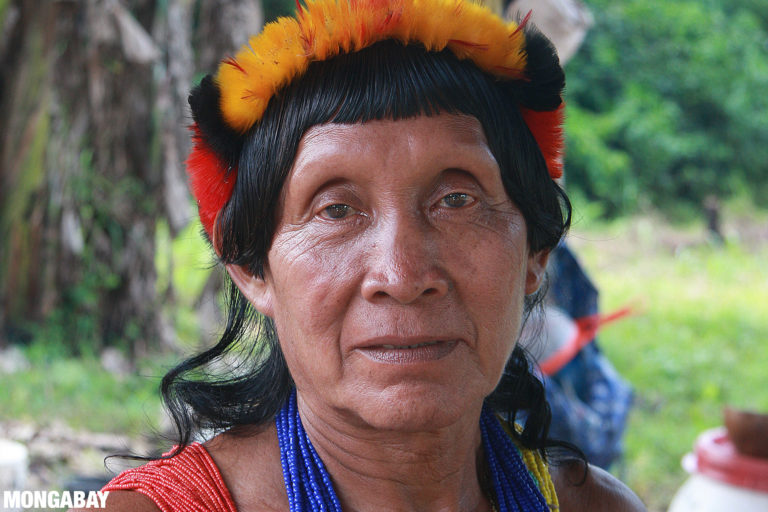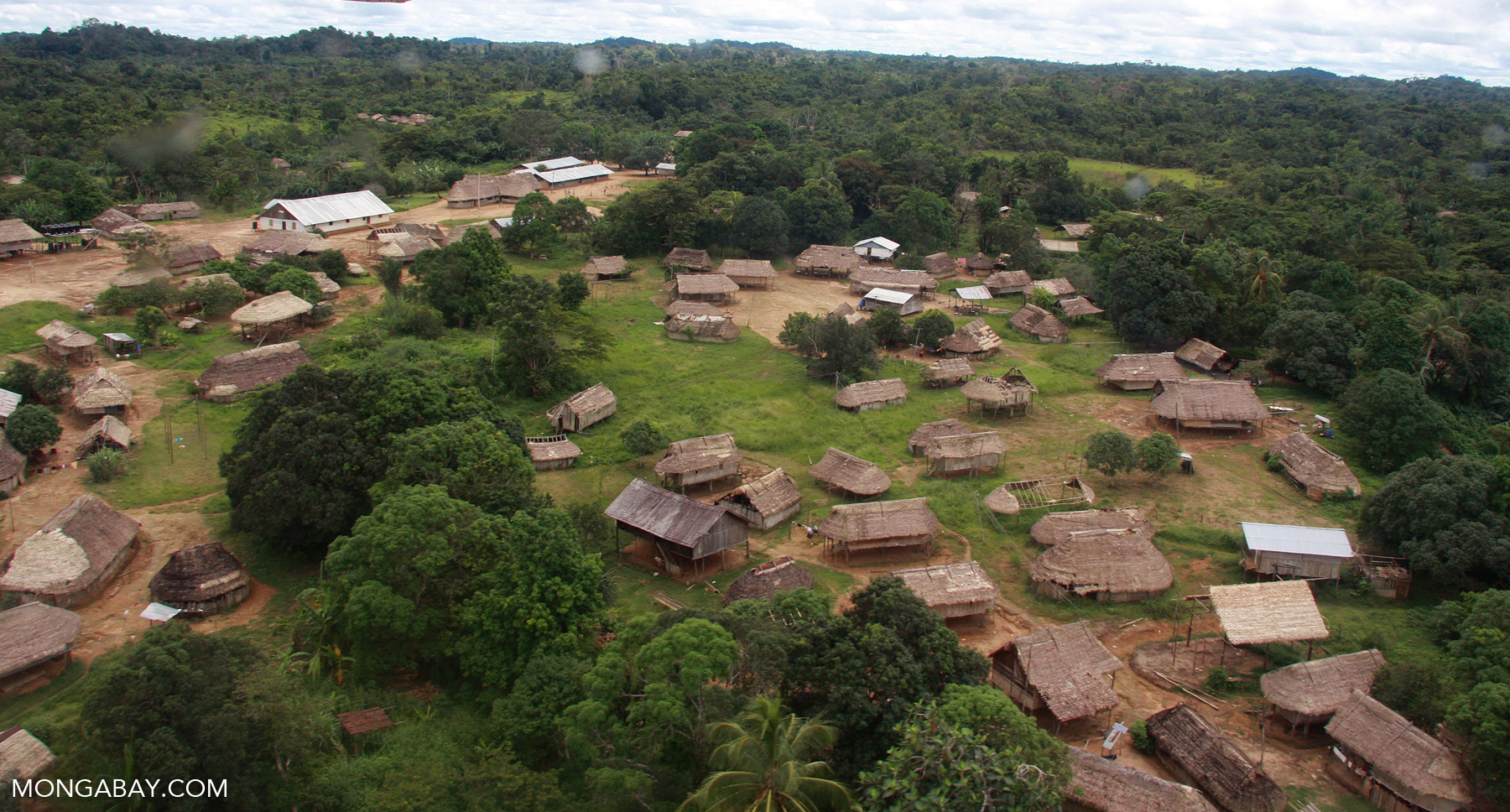A critical part of these programs are village shaman, medicine men and women who serve as custodians of the immense biological knowledge of a people who have survived in the Amazon rainforest for generations. No one understands the secrets of these plants better than these indigenous shamans, but like the forests themselves, this floral genius is fast-disappearing due to deforestation and profound cultural transformation among younger generations. The combined loss of this knowledge and these forests irreplaceably impoverishes the world of cultural and biological diversity.
In June 2008 mongabay.com visited the community of Kwamalasamutu in Suriname to see ACT’s programs in action. During the visit, Amasina, a Trio shaman who works with ACT, answered some questions about his role as a traditional healer in the village. He also unexpectedly noted strange happenings with climate, suggesting that either climate change or regional deforestation is noticeably affecting local conditions.
Please note: The interview was conducted through a translator, so Amasina’s responses are abbreviated.
Q&A with Amasina, a Trio Shaman
Mongabay: How did you learn about medicinal plants?
Amasina: From my mother and father.
Mongabay: Are you passing on your knowledge to the next generation?
 Amasina in Kwamalasamutu, Suriname.
Amasina in Kwamalasamutu, Suriname.
Amasina: Yes, through the Amazon Conservation Team’s Shaman’s Apprentice Program program I teach children how to prepare medicines and use healing plants.
Mongabay: How do you choose apprentices?
Amasina: It is based on trust. I look at the relationship between a person and their parents and whether they get along with the community. I have two apprentices in the program and I am also teaching my son. I also work in the clinic about five days a week and other apprentices learn from me there as well.
Mongabay: Do you see different diseases between local people and foreigners.
Amasina: Local people usually need treatment for the flu, skin diseases, wounds, and diabetes. Foreigners are more likely to need treatment for many ailments that don’t seem to be curable with western medicine, like stress and insomnia.
Mongabay: What did you think of the shaman gathering between medicine women from Colombia, Brazil, Suriname, and other parts of the world? Did you learn from their techniques?
Amasina: It was interesting meeting shamans from other places. Although we don’t speak the same language, I learned a treatment involving leaves to remove disease from a person. And I taught them some of my medicine as well.
Mongabay: Do you ever use plants to help you “see” how to treat a person?
 Amasina in Kwamalasamutu
Amasina in Kwamalasamutu
Amasina: My father and I used a vision plant long ago but now I rely primarily on the eyes. I look in a person’s eyes to see their illness and I also use touch.
Mongabay: It’s evident there has been a lot of flooding here recently. Is this normal?
Amasina: Flooding happens from time-to-time but it seems that the waters are rising higher now than in the past. The rains used to be very predictable but now the system is mixed up. We have rains falling during the wrong time of year. These recent rains did a lot of damage to the cassava crop. The climate seems to be changing and it is affecting us.
The Trio
The Trio (or TiriyĂł) are a Carib-speaking indigenous group that lives in the forests of southern Suriname and bordering areas of Brazil.
 Aerial view of Kwamala village in Sipaliwini District, Suriname. Photo credit: Rhett A. Butler
Aerial view of Kwamala village in Sipaliwini District, Suriname. Photo credit: Rhett A. Butler
 Kwamalasamutu, Suriname. Photo by Rhett A. Butler
Kwamalasamutu, Suriname. Photo by Rhett A. Butler
Encouraged by Christian missionaries and the government to settle in villages in the 1960s, the Trio today primarily in small to medium-sized villages headed by a grandman or chief. Because there are few roads in the remote areas where most Trio live, air strips serve as the only access to the outside world, but few Trio have ever been in a plane — they usually travel by foot or in canoes.
The Trio rely on small-scale slash-and-burn cassava (manioc) cultivation as their principal source of food. This starchy staple is supplemented with fish and game taken from surrounding rivers and forests. The forest provides them with other important resources, notably medicinal plants, building materials, and dyes and resins.
While the missionaries initially banned many traditional practices including shamanic use of plants, some Trio have clung to the use of medicinal plants and shaman are increasingly seen a valuable providers of healthcare to treat many ailments.
Amazon Conservation Team
Related articles
Colombia creates rainforest reserve to protect medicinal plants (06/12/2008) Colombia today announced the creation of a rainforest reserve dedicated to the protection of medicinal plants.
Amazon Conservation Team wins “Innovation in Conservation Award” for path-breaking work with Amazon tribes (12/11/2007) The Amazon Conservation Team (ACT) was today awarded mongabay.com’s inaugural “Innovation in Conservation Award” for its path-breaking efforts to enable indigenous Amazonians to maintain ties to their history and cultural traditions while protecting their rainforest home from illegal loggers and miners.
Amazon rainforest children to get medicinal plant training from shamans (11/21/2007) The Amazon Conservation Team (ACT) — a group using innovative approaches to preserving culture and improving health among Amazonian rainforest tribes — has been awarded a $100,000 grant from Nature’s Path, an organic cereal manufacturer. The funds will allow ACT to address one of the most pressing social concerns for Amazon forest dwellers by expanding its educational and cultural “Shamans and Apprentice” program for indigenous children in the region.
Amazon Indians use Google Earth, GPS to protect forest home (11/14/2006) Deep in the most remote jungles of South America, Amazon Indians are using Google Earth, Global Positioning System (GPS) mapping, and other technologies to protect their fast-dwindling home. Tribes in Suriname, Brazil, and Colombia are combining their traditional knowledge of the rainforest with Western technology to conserve forests and maintain ties to their history and cultural traditions, which include profound knowledge of the forest ecosystem and medicinal plants. Helping them is the Amazon Conservation Team (ACT), a nonprofit organization working with indigenous people to conserve biodiversity, health, and culture in South American rainforests.
Indians are key to rainforest conservation efforts says renowned ethnobotanist (10/31/2006) Tropical rainforests house hundreds of thousands of species of plants, many of which hold promise for their compounds which can be used to ward off pests and fight human disease. No one understands the secrets of these plants better than indigenous shamans -medicine men and women – who have developed boundless knowledge of this library of flora for curing everything from foot rot to diabetes. But like the forests themselves, the knowledge of these botanical wizards is fast-disappearing due to deforestation and profound cultural transformation among younger generations. The combined loss of this knowledge and these forests irreplaceably impoverishes the world of cultural and biological diversity. Dr. Mark Plotkin, President of the non-profit Amazon Conservation Team, is working to stop this fate by partnering with indigenous people to conserve biodiversity, health, and culture in South American rainforests. Plotkin, a renowned ethnobotanist and accomplished author (Tales of a Shaman’s Apprentice, Medicine Quest) who was named one of Time Magazine’s environmental “Hero for the Planet,” has spent parts of the past 25 years living and working with shamans in Latin America. Through his experiences, Plotkin has concluded that conservation and the well-being of indigenous people are intrinsically linked — in forests inhabited by indigenous populations, you can’t have one without the other. Plotkin believes that existing conservation initiatives would be better-served by having more integration between indigenous populations and other forest preservation efforts.
How did rainforest shamans gain their boundless knowledge on medicinal plants? (5/14/2005) For thousands of years, indigenous people have extensively used rainforest plants for their health needs — the peoples of Southeast Asian forests used 6,500 species, while Northwest Amazonian forest dwellers used 1300 species for medicinal purposes. Perhaps more staggering than their boundless knowledge of medicinal plants, is how shamans and medicinemen could have acquired such knowledge. There are over 100,000 plant species in tropical rainforests around the globe, how did indigenous peoples know what plants to use and combine especially when so many are either poisonous or have no effect when ingested. Many treatments combine a wide variety of completely unrelated innocuous plant ingredients to produce a dramatic effect.
Amazon People, Conservation, Culture, Environment, Ethnobotany, Featured, Forest People, Forests, Green, Indigenous Cultures, Indigenous Peoples, Interviews, Medicinal Plants, Rainforest People, Rainforests, Tribal Groups
Amazon, Latin America, South America, Suriname
Source link : https://news.mongabay.com/2008/07/an-interview-a-shaman-in-the-amazon-rainforest/
Author :
Publish date : 2008-07-28 03:00:00
Copyright for syndicated content belongs to the linked Source.












